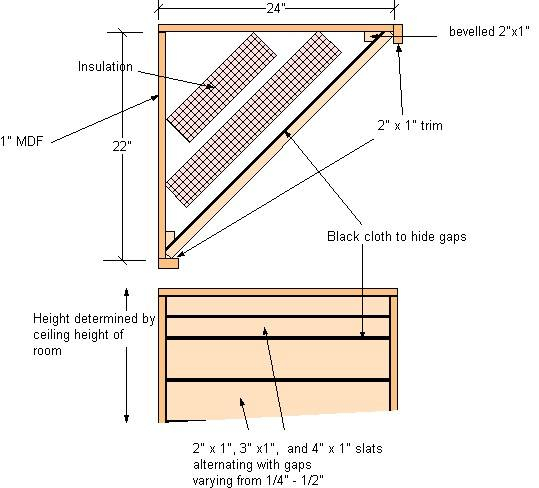No products
|
LOW - MID ABSORBERS If you look at the absorption coefficients of various materials you will notice that some of the fibreglass products absorb low-mid frequencies very efficiently as does a panel absorber with a fibreboard panel instead of a plywood panel. But the best low mid absorber (and the best looking) is the helmholtz resonator - often called a slat resonator. The helmholtz resonator (named after a Mr Helmholtz who discovered it) can best be demonstrated by taking a normal soft drink bottle and blowing over the mouth of the bottle - a note is produced. Now place some cotton wool in the bottle and try again. You will notice the note has reduced- well not really, the note is produced but the wool absorbs the resonance and turn the sound energy into heat! Imagine, if you lined a whole wall with bottles of various sizes, all filled with insulation material. You would now have a low-mid (200 - 500Hz depending on the bottle size) absorbing wall that as well as absorbing the low mids would also reflect or diffuse the high frequencies. I haven't tried it yet but it would be worth trying if you are short of cash because bottles are cheap. The Romans used to do it using clay jars which they placed around their theatres. The helmholtz resonator is often called a slat or slot resonator because you can create a helmholtz resonator by building a wall with slats of timber separated by slots as in the following diagram |
||
|
||
| Further more, our scientists have created a formula with which we can tune the resonator to a specific frequency. If we vary the depth from the wall, slat width, slot width (and the slat depth) we can create a wall that is a broadband low-mid frequency absorber. The beautiful thing about these absorbers is that they still reflect high frequencies, in fact they will diffuse them which is even better. | ||
|
||
|
As you can see a slat wall like this can break up parallel walls thus stopping standing waves. Because the distance from the front to the back is varying from 300mm to 100mm or around 12 degrees, the wall becomes a broadband absorber. So simple yet so effective! I've seen some beautiful looking ones where you cut the slots out of a sheet of quality particle board with a timber veneer. Another form of helmholtz resonator is created using perforated plywood - i.e. plywood with hundreds of holes in it. We call it pegboard in Oz, you see it in hardware stores holding up tools etc. If you place a panel of this over an air cavity like in a panel absorber not only do the little holes act like bottle necks the whole panel acts as a low frequency panel absorber! The formula for calculating the helmholtz resonant frequency is: 2160*sqrt(r/((d*1.2*D)*(r+w)))
Where: f = resonant frequency in Hertz (Hz)r = slot width. w = slat width. d = effective depth of slot. (1.2 x the actual thickness of the slat) D = depth of box. You can open the Helmholtz Calculator formula as an Excel file and do your own calculations. |

